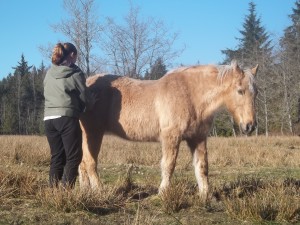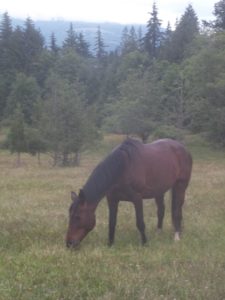Touch
The Rest State and Dying

11/6/18
One of the things that bothered me about euthanizing Maya, was that she did not want to go. If I let her make the call, she would have died on her own. I’ve known many people who have euthanized their animals when the animal “told” them it was time. I had never heard of the opposite happening, until it happened with Maya.
In my research so far, what I’ve learned is that when she was in pain and no veterinary medication could help it, she was in the sympathetic nervous system state. That is the fight or flight.
Then I read about someone’s experience massaging above the eyes of a horse in a similar situation. She was able to slow the horse’s respiratory rate; the horse stopped thrashing around and closed his eyes. What I find fascinating about this is that she was able to help the horse move from the sympathetic to the parasympathetic nervous system (which is the rest state).
Thank you, Donna, for the tips about the acupressure points, and thank you Ellen for the suggestion of Lavender essential oil for a calming effect. What’s coming into focus for me is that while veterinary medicine could provide euthanasia, it could not provide the transition to the rest state in the dying process for Maya. What gives me hope is that through natural remedies that transition is possible.
Every death is unique and has its own set of circumstances, and there are no guarantees. Would I have still euthanized Maya? Perhaps. But I now have more tools to even try helping a horse to come to a rest state before they take their last breath.
From my martial arts training, it is in the rest state that there are a myriad of options that are not known to the rational brain. There is great hope there. Thank you, Maya, for allowing me to discover that.
Being “With” Pain
10/11/18
Someone told me once, you don’t necessarily have to fix the pain, and maybe you can’t fix the pain, but you can be present with someone in their pain, and that is a gift. A few days before Maya died when we were trying to figure out how to best help her, there came an evening where there was nothing more to do, but wait until morning. I gathered up all my tricks that I had learned over the years of rehabbing old horses and put them in my pockets. I headed out in the dark, the moon just beginning to rise, to find Maya in her usual spot under the trees, hanging out with my other horse who she became instant friends with. They were in very close proximity which told me that, yes, they are friends, and also that she was not feeling that great.
I pulled my tricks out of my pockets one by one to see which ones she wanted. She said yes to one lick of yucca, which is a pain relieving herb. She was agreeable to flower essences on the tips of her ears. She enjoyed the Ttouch wraps so much that she fell asleep. I did a little energy work, and then prayed over her. After a long time, when she was ready to go eat, she slowly meandered off. I was glad that she still had the energy to let me know when she didn’t want anything more.
That evening I couldn’t fix the myriad of health issues going on, but I could acknowledge her and be with her in her time of need. It is moments like these that I cherish.
If you are new to Ttouch wraps and flower essences, here are some resources:
Ttouch wraps: https://www.youtube.com/watch?v=MgENe3frTfY
Flower essences: http://seniorhorserehab.com/flower-essences-and-grief-in-h…/
Ttouch for Colic
10/7/18
At the beginning of the week Maya died, just after the vet diagnosed a mild gas colic I recalled that Ttouch had bodywork techniques that I could do with Maya to help her resolve the colic.
I came out one evening after work. It was dark, and I walked into the field to see where I might find the horses. Before I got very far, my other horse came and found me, parked and asked to be itched. I itched away, and when I looked up, there was Maya waiting right behind him.
I eventually made my way to her, and did the belly lifts with the towel described in the article below. She relaxed and cocked a hind leg. After a long time, when she had gotten what she wanted, she wandered off back into the field, the moon having just risen. I was glad that there was something I could do to help her feel better.
http://www.intouchwithyourhorse.com/resources/TTouch%20tools%20for%20Colic.pdf
The Body Language of a Request
Having spent years learning to ride and then learning to train horses, all of the focus was on training the horse to do what I asked. I learned a lot about horses and how to train them and how to ride them, however, I didn’t really know them.
When I took in my first senior horse to rehab several years ago, my focus was different. It was no longer about me, but rather about the horse and what could I do to help facilitate bringing him back to full health. The only question I asked of the horse was, “What can I do to help you be fully alive?”
What I have learned over the past several years rehabbing senior horses is that every moment of every day horses are speaking through their body language. Much of it we miss and don’t understand.
Just the other day I went out to see my horse, Chaco. I missed him, and as much as I wanted to go up to him and give him a big hug, I held back and simply took a meandering walk in his direction to see if he was okay with me approaching him.
He was standing, taking a nap, and I stopped and waited several feet away from him. Eventually I slowly approached his shoulder. He seemed okay if I put my hand on his shoulder, and he would close his eyes in certain places where I placed my hand, but the look in his eye alternated between going to sleep and being fixed.
I searched for how could I touch where his ears did not go back in the slightest way and where his eyes started to close. It was a tricky dance to dance that day. I couldn’t quite find the perfect spot for very long. I really wanted to give him a hug, but because I was having difficulty finding just the right spot to place my hands, I knew he was already tolerating me touching him, and a hug was not what he wanted.
So I took a step back and went around to the front of him. When I stood there looking at him his expression and eyes and ears were softer and more accepting so I stayed there.
Looking at him, I asked out loud, “How can I help you?”
I had no answer myself, and I wondered if he felt o.k. I just watched him and his body language, hopeful that he might enlighten me.
After a few minutes of me breathing, relaxing and just observing him while I asked that question, he eventually turned his head 90 degrees to his left and looked at the field on the other side of the fence.
I had seen that look in his eyes before. (It was when we took a walk down the road and he just meandered to a stop at a neighboring driveway, turned his head 90 degrees and looked down the driveway and then back at me. I knew there was a grass patch at the end of that driveway that he liked to graze, so we took a detour to the grass patch, and I let him graze).
So standing in the field with him this particular day and seeing that familiar look in his eyes, I took a chance and took off his halter, grabbed the grooming bucket I had brought out with me and walked over to the gate while telling him, “Come on, Chaco, let’s get out of here and you can have some goodies (i.e., the green grass).”
“Would he come with me?” I wondered to myself.
Since the gate was only 25 feet away, it didn’t take me long to get there, but knowing that a horse’s resting heart rate is half the rate of a human’s, I knew it might take him several minutes to stroll over to the gate. I also still wasn’t even sure he was asking me to let him out.
Sure enough though, not far behind me, he came. Of course, his pasture mate perked up when she saw that he was going to get out.
In my mind I’m thinking, “Come on, Chaco, let’s go before she gets up here.”
Chaco almost picked up a trot, got to the gate, and I was just able to close it in time so only he got out.
We proceeded to have a lovely afternoon. He grazed for a few minutes, and then we went for a walk down the road and brought his pasture mate along. He moved out well, navigated a tight spot through the trees and bushes on a trail and found some sword ferns to nibble on in the process.
All of this happened because I refrained from hugging him, and instead stopped and observed him to try and figure out what he wanted.
The glare in his eyes and the ears slightly back were a “no” to my hands touching him. The 90 degree turn of his head to the left in the direction of the neighboring pasture was a request.
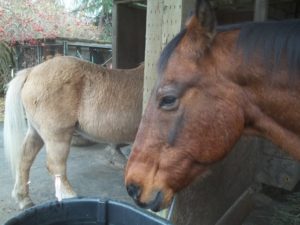
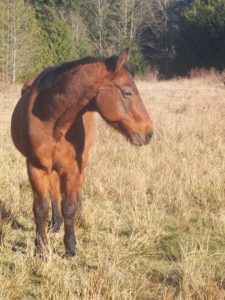
When we slow down and take time to register every little movement a horse makes and ask ourselves what that might mean, we start to discover that they are communicating all the time.
I’m sure I’m just on the tip of the iceberg of what he is communicating to me. The more I listen, the more he teaches me the body language of horses, and the more I discover who he is. For me, that is why I rehab senior horses.
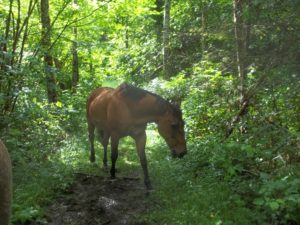
Horse Kisses
My seven year-old niece visited recently and really wanted to take my horse, Chaco, for a walk. After finishing the barn chores, we took a grooming bucket and halter out into the field and went looking for Chaco. We found him taking a nap enjoying the dry afternoon of no rain.
He was caked in dried mud from the day before, and we began the process of brushing all of it off of him. Yes, we could just halter him and take him for the walk, but the day was dry. His hair was dry, and the mud was dry enough to brush it out. Since it could rain at any moment, we decided to go with brushing him out first.
There was so much dried mud that plooms of dust encircled him as we brushed. You had to keep your mouth shut, lest a mouthful of grit and dirt got in. Soon we cleaned him up, and he was still enjoying his quiet time napping.
I showed my niece how to gently place the palm of her hand on his coat and just breathe and relax. As she did this, I instructed her to watch his eyes. If they blinked or started to close, then he liked how and where she was touching him. If they stayed wide open, then he didn’t like it. In that case, I told her to lighten her touch, or move her hand over a millimeter or just breathe and relax more herself.
This became an ongoing dance with Chaco. At times, he closed his eyes completely. Other times he held his eyes open. At one point we decided to give him some space, so we stepped away from him.
She then asked, “Can we take him for the walk?”
I responded, “Yes, we could, however, when you look at Chaco right now, what is he really enjoying?”
“His nap,” she acquiesced.
I explained further, “With horses, you may come with a plan to do a particular thing, but if they present a different opportunity to you, then I’d take what they offer. You never know when that offer will come again.”
Despite really wanting to go on the walk, my niece understood, but was disappointed.
Seeing how I might be able to cheer her up, I asked, “Have you ever kissed a horse at the base of their ear? It is the most heavenly spot.”
She never had, so I picked her up and stood a few feet away from Chaco in front of him off to one side. As I held her, and before we approached, I explained the details of being around the head of a horse, where it could move suddenly, and how to keep herself safe, if he were to move.
No sooner had I finished the safety talk, that Chaco lifted his head up out of his nap and stretched his neck out toward us, putting his whiskers and muzzle ever so gently against her cheek and breathing on her. His eyes were soft, and he was curious about who this little girl was, checking her out and taking her all in. We stayed there, not moving an inch, and just savoring this gift Chaco was imparting to her.
When Chaco was done my niece said, “He gave me horse kisses.”
“Have you ever experienced that before?” I asked.
“No,” she replied.
“If you had to pick between horse kisses and a walk, which one would you pick?”
Without hesitation, she said, “Horse kisses.”
“Aren’t you glad we didn’t go for the walk earlier?”
“Yes.”
“It is because we honored his nap and went along with what he was already doing, that the opportunity came for him to give you the gift of horse kisses.”
Those horse kisses became the highlight of her visit. To be fully acknowledged and accepted by a 1000 lb. animal just out of their own curiosity is a magical experience. It is what keeps me coming back to them. It’s why I shovel manure in the rain, why I get up early to feed them, and why I spend hours researching how to improve their health.
You never know when the magic will happen, but if you spend time just being with them with no agenda or expectations, they will surprise you over and over. That is the world they live in, and when I get a glimpse of it, it makes the commitment to them all worthwhile.
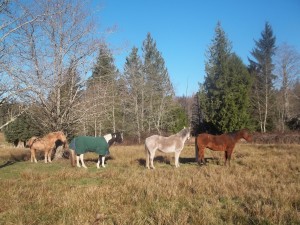
Body Language of Happy Horses
Here at God’s Window, we keep our horses in a herd on acreage year-round. They come and go as they please. The more natural their living environment, the healthier they are. Having space to move day and night, and the companionship of other horses is vital to them thriving.
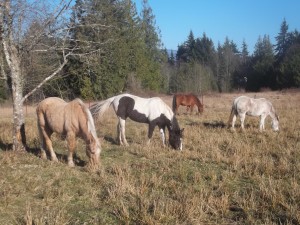
When I go out into the field to visit, it’s not uncommon for them to come over to me. It usually starts with Thunder. He sees me from afar and looks right at me. I head in his direction, and then walk right past him just to confirm if he really wants to be with me. I find a tree to sit under, and he inevitably comes over and puts his hips in my hands. He wants to be scratched.
After several minutes the rest of the herd begins to meander our way. Chaco, the herd leader, picks up a walk with his head low, ears forward, and soft eyes, (a submissive posture), coming straight for me. I know he wants me to put my hands on him, but my hands are already full with Thunder. If he keeps coming, Thunder will move away out of respect, so I square up my shoulders to Chaco to stop him in his tracks about 20 feet away. He defers to my request, but I know he wants me to leave Thunder and come over to him. After a few minutes of scratching Thunder, I give Thunder some final pats before heading to Chaco who has been waiting patiently.
In this scenario there’s no ear pinning, tail swishing, eye glaring, nor a high head, all of which are stress signals. Instead, eyes are soft, ears are forward, tails are quiet and heads are low. This is the body language of a horse at ease in its environment, and in this case, the environment includes a person.
How often do you see horses giving stress signals in their interaction with people? How often do you see the opposite, horses so comfortable in their environment that they want to interact with people? Horses and people are living, dynamic creatures and stress here and there is a part of being alive. However, how can we cultivate a relaxed state in ourselves and in our horses?
Looking Right At You
A riding instructor once told me, “If a horse looks right at you, they are asking you a question.”
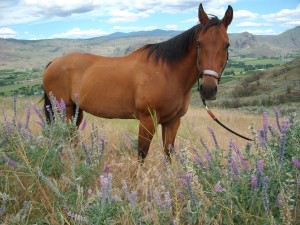
I hadn’t ever thought of it like that before, but from that moment forward every time a horse looked right at me, I stopped and paused in myself to see what they wanted. I just started assuming they wanted something from me, and I set out to figure out what it was.
One afternoon, after visiting my horse, I prepared to leave while he was eating his hay like he always did. I said goodbye to him and walked to my car, taking off my boots and putting my barn coat in the trunk. As I got into my car, I looked over at him and was surprised to find him staring right at me. He had left his food, which he never did, and pointed himself in my direction looking straight at me.
Since this was out of the ordinary, I knew he wanted something. I went back over to him and asked out loud what he wanted while I practiced relaxing and breathing. I checked for gut sounds. They were o.k. (No gut sounds means colic). I then put my hands on him and slowly searched for the spot where he would relax and close his eyes. Sure enough I found it on his right hip. Just barely touching with my hands, his closed eyes told the story. That was the spot. (This was also the spot he had fallen on several weeks earlier).
A chunk of time passed, and when he was done with me resting my hands on him, he licked and chewed, threw in a few yawns and went back to eating his hay. He had successfully communicated and got what he needed.
When your horse looks right at you, take a moment to see what they might be asking you. Allowing time to slow down, breath and observe your horses does wonders for communication. They just might surprise you. I’d love to hear what you learn.
A Horse Won’t Hold Its Foot in the Air for You. Right?
“Well, it’s not like the horse is going to hold their foot in the air for you to clean it out.”
This is a common assumption in human thinking. However, if you try on some “horse thinking”, all of a sudden the idea of a horse holding its foot in the air for you becomes completely reasonable and normal.
When it comes to cleaning the feet of a horse it’s a job that needs to be done, and as humans beings we are a predator (eyes in the front of the head, canine teeth for eating meat), and we are straight line thinkers. The quickest route from point A to point B is a straight line.
Contrast that with prey animals. Their eyes are more on the side of their head. They don’t have teeth for eating meat and their default is a meandering line, not a straight line. If a horse feels a straight line, that’s a big tip off to them that they’re being stalked by a predator and are about to be dinner.
Several years ago I used to volunteer with a horse therapy program for at-risk youth. One client I worked with was having trouble picking up the feet of her horse. She was so focused on getting a hold of the hoof that she would try, fail and then give up. She repeated this process so many times that soon the horse didn’t even bother to listen to her. The horse eventually kept all its weight solidly on the very foot she wanted to pick up. She was very much in straight line thinking. The horse was very much resisting.
I remember telling her to forget about picking up the foot. Instead look for a green light from the horse, no matter how tiny, like a shift of weight, and then pet the horse’s leg immediately. She did this several times. She got better at asking slowly so she could better sense the very beginning of when the horse started to cooperate. The moment the horse began to cooperate, she went to petting the horse’s leg. She did not care about what the foot was doing.
After several times of doing this, the horse decided to hold his foot in the air for just a moment. Amazed, she was about to grab it, thinking she could finally clean the foot.
I abruptly stopped her and said, “Resist the temptation to grab it. Instead, ignore it, and just pet the horse’s leg.”
She was able to over-ride her straight-line thinking, and just pet the horse’s leg. After a couple of times of this routine, the horse eventually held its foot relaxed in the air for several seconds, the longest he ever had. I knew he was ready for her to clean it out. And so she did, with complete continued cooperation from the horse.
Yes, you can get a horse to do things using straight line thinking. If the barn is burning down and you need the horse out of there now, straight line thinking will get the job done. But what if the barn isn’t burning down? What if there is no emergency? Then what would our interaction with them look like with a round about line, the kind of meandering line that horses spend the majority of their day doing?
This is where horses show us humans another world. If we have the patience and courage to enter their world and see it as they see it, a whole new experience unfolds before us. It’s where the magical moments with horses reside, where they want to be with you, and they want to interact with you of their own free will. Once you get a taste of a horse seeking you out, nothing can compare. It is heaven on earth.
Too Much Touch?
When I took in my second senior horse to rehab, Thunder, he did not want to be touched. He preferred to walk away rather than be groomed. If you stayed in his space he would nudge you away with his nose. He made it clear he needed space, and lots of it.
He had just retired from eight years as a therapy horse for at-risk youth doing a wonderful job taking care of and teaching the kids. The work, however, did not come without a price. He wore out, and he made it increasingly clear his last year on the job that he wanted to retire.
The first year he was in my care I rarely touched him. About nine months in, he would let me brush his legs while he took a nap in the field, but don’t touch his belly. If I tried to brush his belly he would walk off.
Today, three years later, he lets me brush all of him, and he even shows me his spots he wants scratched. It’s me who gets tired of scratching him, and I want to stop. It takes a long time before he decides he’s had enough scratching. This is a huge change from when he arrived three years ago.
What’s the secret to this change? If he walked off, I let him. I may have had an idea to brush him a particular day, but if he said no by walking off, then I respected that. Once he knew he could say no, and I would respect that no, then he started saying no less often.
Now I’m starting to see the yes when he puts his hips in my hands to scratch him. Because I have allowed him to walk off, I am thrilled when he decides to stay. That is his yes. It’s been three years in the making, and it’s a wonderful thing to have straight from the horse’s mouth.
